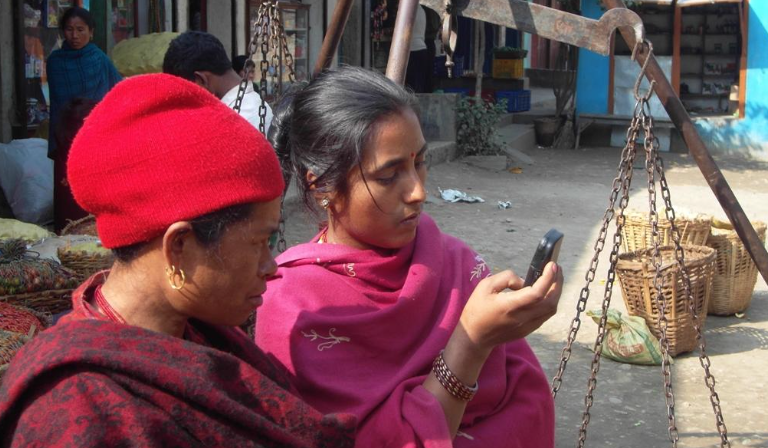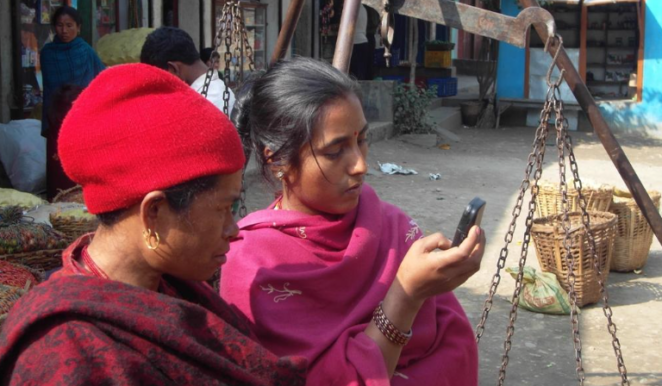Using Mobile Phones to Reduce the Adversities of Climate Change in Rural Nepal


About the project
The Climate Change, Innovation and ICTs Project is an initiative led by the Centre for Development Informatics (CDI) of the University of Manchester, UK, with funding support from Canada’s International Development Research Centre (IDRC). Further information about the project and related resources can be found at: http://www.niccd.orgOverview
The initiative described in this case is part of a disaster risk reduction project implemented by Practical Action in Nepal, financially supported by the UK’s Department for International Development. The initiative aims to build resilience by improving the livelihood assets of vulnerable communities, and the work reported here focuses on the rural communities around Kirtipur in Nawalparasi District in South-Central Nepal.
The villagers rely mainly on agriculture, supplemented by seasonal migration for work. But the lack of technical and other inputs mean that agricultural outputs are limited to subsistence level. Inhabitants report signs of climate change including greater variation in precipitation and higher temperatures in both summer and winter, which is affecting agricultural use patterns and productivity. In addition, the area has a fragile geography, with agricultural and other land subject to flooding; a phenomenon that has been increasing in recent years. With a growing number of mobile phones coming into the area, this initiative sought ways to use these new ICTs to reduce vulnerabilities, including the vulnerability to climate-related disasters, and more generally to improve agricultural livelihoods. It did this by developing a phonebased early warning system allowing upstream and downstream communities to exchange information on flood signs and occurrences. It also developed a list of service providers and traders with whom the farmers could communicate for agricultural and value chain information.
Objectives/Purpose for ICT Usage
The project recognised that it was not possible to separate out the role of climate change within either agriculture or disaster management. But, recognising that the effects of climate change will be worse for those with weak livelihood asset bases, the project sought to more generally build the resilience of the communities involved by strengthening their access to information and, in turn, strengthening their productivity and income generation. Along with other interventions, the project promoted the use of ICTs to reduce vulnerabilities – including climate change vulnerabilities – and to help the communities avoid, mitigate and cope with the effects of climate related disasters, and to adapt to the longer term changes in the local climate. It aimed to do this by using mobile phones to provide greater access to information on (1) the production and marketing of vegetables, other crops and livestock; and (2) disaster risks.Evaluation: Failure or Success
It seems appropriate to categorise this initiative as a success in terms of benefit obtained from investment. The linkages established last beyond the lifetime of the project and provide more opportunities and enable farmers to build more confidence and social capital. Income from agriculture has been increased particularly from vegetables. Increase in incomes and strengthened livelihood options have paved the way to resilience. Slash and burn has been decreased giving the watershed an opportunity to improve its health. Risk of life and other loss from flooding has been decreased. Of course, the ICT is just one among a raft of elements but it does appear to be helping these vulnerable communities not just avoid and recover from disasters, but also build a deeper adaptive capacity (particularly in relation to information, skills and income) that will enable them to cope better with the longer term challenges of climate change.
Constraints and challenges
Notwithstanding the point above about mobiles now being an “organic” technology within many developing country villages, the timing of this project just as mobiles were diffusing into the community did present challenges. Most users were new to mobiles and unfamiliar with them. The majority of Kirtipur’s citizens were illiterate and the phone fascia and any related text were in English, further lengthening the learning curve. Being without electricity, villagers had no access to television – which ran informational broadcasts about using ICTs. Thus it took some time for those involved to become familiar and then confident with using mobiles.And, notwithstanding the point above motivation of participants, the validity of some of the information provided was sometimes questionable but hard for the villagers to assess due to their limited broader knowledge on issues. Information on market prices was not always reliable (for example, sometimes traders did not wish to buy items and so were not motivated to provide a correct price), though comparison across traders could help avoid this problem. And there were concerns about false positives in the reporting of flood dangers. There could be a number of instances of flood warnings being given and leading to households, etc being moved but then no flood ensuing; particularly as there was no objective measurement of rainfall by the upstream communities. Such instance would eventually lead to flood warnings being ignored.
Recommendations/lessons learned
The following lessons were learned from this case study:
1) Mobile phones can form a key foundation for ICTs’ contribution to climate change adaptation generally, including disaster management more specifically. In very many – and an increasing number – of developing country locations, mobile phones are already in place and in use. The work of disaster and adaptational projects therefore becomes not the introduction of a new technology, but the introduction of new ways of using the technology.
2) Simple applications can still be effective. At root, this project did little more than providing a miniphone book for project participants. Yet, given their lack of social capital and their lack of broader knowledge, this had quite a significant impact in providing disaster and agricultural information which then had broader knockon impacts on livelihoods that strengthened resilience and capacity to adapt longerterm to climate change.
3) The ability to avoid and cope with disasters, and the ability to adapt to climate change depend on many components – assets, institutions, structures – etc. However, money remains critical; likely to most important single prophylactic against the vulnerabilities that climate change can intensify. Adaptational projects can therefore benefit if they incorporate incomeraising and incomediversifying components, as this one did in relation to agricultural productivity and sales.
4) There are many success factors in a project, but human motivation is arguably the most important. If ICT and disaster/climate change projects can provide a good answer to the question, “What’s in it for me?” for the key stakeholders, it will be far more likely to succeed. In turn, understanding what will answer that question will often depend on a detailed and participative initial assessments of needs, wants and values.
Enablers/Critical Success Factors
The key to understanding success or failure of any project involving ICTs and climate change, is to understand the motivations of the people involved. This project has worked well – and seems likely to sustain in future – because virtually all the stakeholders involved derive some benefit from it.Of course, the hardships faced the communities due to poor agricultural productivity and the damage done by flooding were a strong motivator for the prime beneficiaries and, as seen, the delivery of higher outputs, income generation and some protection from climaterelated disasters ensure continued motivation and participation. However, motivating core beneficiaries in a project is relatively easy. Harder is to motivate the secondary stakeholders on whom success of the project still, nonetheless, rests. But in this case, the project does seem to have created a winwin because those other stakeholders – other community members, traders, agricultural service providers, even the mobile providers – find themselves gaining something in return for their involvement: information and/or direct income and/or savings due to foregone journeys.
Technology itself was an important enabler: the project would most likely not have worked if farmers could only get mobile network coverage when they travelled to nearby towns. But more important was the role of technology within the project. Unlike many ICT projects in development, this one did not invent or introduce anything new. Instead, it relied on a technology – mobile phones – that were already (albeit quite recently) in quite widespread use within the project area. Instead of the “inorganic” project approach that brings in a new technology from outside, we can therefore call this an “organic” approach that built from the existing foundations. It did not seek to innovate technologically; instead it innovated socially and commercially using the base already present. It did not require a project intervention to cause mobiles to be used in this rural area. But it need require Practical Action’s intervention to cause the mobile to be used in a way that facilitated disaster management, agricultural productivity, and longer term building of resilience to climate change.
(0) Comments
There is no content